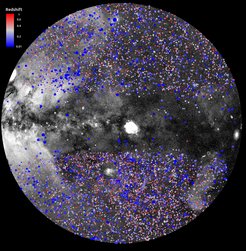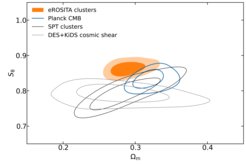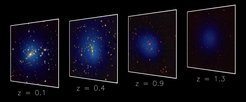eROSITA relaxes cosmological tension
Results from the first X-ray sky survey resolve the previous inconsistency between competing measurements of the structure of the Universe
A new analysis of how galaxy clusters evolve over time has yielded precise measurements of the total amount of matter in the Universe and its degree of clumpiness. These and other findings were reported in a set of articles released today by scientists of the German eROSITA consortium, led by the Max Planck Institute for Extraterrestrial Physics. The results alleviate the tension between previous clumpiness measurements, while at the same time offering insights into the elusive measures of the neutrinos mass and of the pressure provided by dark energy. The analysis is based on one of the largest X-ray catalogues of galaxy clusters, also released today. Most of these are previously unknown, showcasing eROSITA's ground-breaking discovery potential.

Two weeks ago, the German eROSITA consortium released its data from the first all-sky survey. The survey's primary goal is to better understand cosmology via the measurement of the assembly of galaxy clusters over cosmic time, some of the largest structures in our Universe. Tracing the evolution of clusters via the X-rays emitted by hot gas, eROSITA has made precision measurements of both the total amount of matter in the Universe and its clumpiness. The eROSITA measurements resolve previous inconsistencies between past clumpiness measurements using different techniques, specifically the cosmic microwave background (CMB) and weak gravitational lensing.
“eROSITA has now brought cluster evolution measurement as a tool for precision cosmology to the next level,” said Dr. Esra Bulbul (MPE), the lead scientist for eROSITA’s clusters and cosmology team who delivered the ground-breaking results. “The cosmological parameters that we measure from galaxy clusters are consistent with state-of-the-art CMB, showing that the same cosmological model holds from soon after the Big Bang to today.”
According to the standard cosmological model, called the Lambda Cold Dark Matter (ΛCDM) model, the infant Universe was an extremely hot, dense sea of photons and particles. Over the course of cosmic time, tiny density variations grew into the large galaxies and galaxy clusters we can see today. The eROSITA cluster observations show that matter of all kinds (visible and dark) comprises 29% of the total energy density of the Universe at present, in excellent agreement with the values obtained from measurements of the cosmic microwave background radiation, which was emitted when the Universe first became transparent.

As well as measuring the total matter density, eROSITA has also measured the clumpiness of the matter distribution, using a parameter called S8. An important development in cosmology in recent years has been the so-called “S8 tension”. This tension arises because cosmic microwave background experiments measure a higher value of S8 than, e.g. cosmological weak gravitational lensing surveys. New physics is implied unless this tension can be resolved, and eROSITA has done just that. “eROSITA tells us that the Universe behaved as expected throughout cosmic history,” says Dr. Vittorio Ghirardini, the postdoctoral researcher at MPE who led cosmology study. “There's no tension with the CMB - maybe the cosmologists can relax a bit now.”
The largest structures in the Universe also carry information about the smallest particles: neutrinos. These lightweight particles are nearly impossible to detect. “It may sound paradoxical, but we have obtained tight constraints on the mass of the lightest known particles from the abundance of the largest objects in the Universe,” said Ghirardini. Even though neutrinos are small, they are “hot”, i.e. they travel with almost the speed of light. Therefore, they tend to smooth out the distribution of matter – which can be probed by analysing the evolution of galaxy clusters in the Universe. “We are even on the brink of a breakthrough to measure the total mass of neutrinos when combined with ground-based neutrino experiments,” adds Ghirardini. Cluster evolution in eROSITA data alone indicate an upper bound to the total mass of 0.22 eV; combined with CMB data, this reduces even to 0.11eV at a 95% confidence level. This is the tightest combined measurement to date from any observational cosmology probes.
A tour of galaxy clusters in eROSITA
eROSITA’s insights into the nature of the Universe may not end there. Theories of gravity predict that large cosmic structures should grow at a certain rate as the Universe evolves. The eROSITA data can measure this growth rate. The current analysis has already ruled out a set of extensions of Einstein’s Theory of General Relativity. “But more is to come,” says Dr. Emmanuel Artis, a postdoctoral researcher at MPE. “If we find any hints, eROSITA may pave the way for new exciting theories beyond general relativity.”
All these results are based on one of the largest pure catalogues of clusters of galaxies to date, which is also being released to the public today. In the Western Galactic half of the first eROSITA all-sky survey, the scientists detected 12,247 optically identified X-ray clusters of galaxies. “Of these, 8,361 represent new discoveries – almost 70%,” marvels Dr. Matthias Kluge, a postdoctoral researcher at MPE who is responsible for the optical identification of the detected clusters. “This shows the huge discovery potential of eROSITA.”

When charted in three dimensions, the galaxy clusters are situated at the intersections of a so-called cosmic web. The supercluster catalogue, also released today, maps the connected galaxy clusters and the large-scale filaments connecting them. “We find more than 1300 supercluster systems, which makes this the largest-ever X-ray supercluster sample,” said Dr. Ang Liu, a postdoctoral researcher at MPE.
Another key secret of the successful experiment was the ability to fully reproduce the eROSITA observations with large computer simulations. „In this way, we could fully grasp the clusters content of the eROSITA data, by understanding those we missed“, says Dr. Nicolas Clerc, researcher at IRAP in Toulouse. „Addressing these so-called ‚selection biases‘ was an extra challenge for our work“.
Finally, in order to measure the mass of each cluster, scientists in the eROSITA team used a weak gravitational signal derived from three optical surveys: the Europe-led KiloDegree Survey, the US-led Dark Energy Survey, and the Japan-led Hyper Suprime-Cam Subaru Strategic Program, a true global endeavour. The so-called weak gravitational lensing effect occurs when the light from background galaxies is distorted through gravitational interactions with the foreground cluster. “We then decode these distortions to determine the weight of clusters,” said Sebastian Grandis, who is a senior scientist at University of Innsbruck.
„As we reflect on this monumental achievement by the eROSITA team, we eagerly anticipate the exciting future discoveries that will emerge and deepen our understanding of the origins and evolution of the Universe we live in,” emphasized Dr. Esra Bulbul. The eROSITA team is excited to continue analyzing the 4.5 full sky surveys completed in February 2022. “When the full data are analyzed, eROSITA will again put our cosmological models to the most stringent test ever conducted through a cluster survey.”
eROSITA clusters in 3D
Note
This project has received funding from the European Research Council (ERC) under the European Union’s Horizon 2020 research and innovation programme (grant agreement No 101002585)














